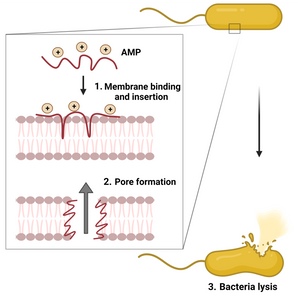
The problem of antibiotic resistance is leading to rising fatalities due to bacterial infections world wide and extensive research into antibiotic resistance has uncovered that more and more bacterial species are becoming immune to antibiotics. In order to protect against bacterial resistance, antimicrobial peptides are investigated for targeting bacterial resistance.
Antimicrobial peptides (AMPs) are natural cationic molecules that play an important role in the innate immune system of different organisms. AMPs differ from conventional antibiotics in terms of pharmacokinetics, a more narrow mutation window and fast effectiveness in killing bacteria as well as viruses and fungi. As AMPs have a natural ability to bind and permeate the negatively charged membranes of both Gram-positive and Gram-negative bacteria (see image), they offer a new and more varied approach to target infection. Moreover, the diversity offered in AMPs from their conserved nature has led to investigations into antiviral and antifungal solutions as well. Resistance to AMPs occurs much less than to conventional antibiotics.
The ability of bacteria to survive lethal concentrations of AMPs without a genetically encoded resistance mechanism has been studied by researchers at Freie Universität Berlin, in Germany who used two AMPs (mellitin and pexiganan) due to their broad applicability against Gram-positive and Gram-negative bacteria, as well as parasites and cancer cells. They have shown that as a response to sub-lethal doses of AMP’s, E.coli are able to develop not only a tolerance, but an increased persistence to lethal AMP treatment by producing curli in their biofilm. Their findings show that although AMPs offer a simple and effective solution to the antibiotic resistance crisis the world is facing today, they must also be used correctly. The risk of tolerance and resistance of bacteria to these AMP treatments exist and must be considered. EbbaBiolight can aid in establishing increased tolerance to AMPs due to its ability to detect and quantify curli content in the bacterial extracellular matrix of Gram-negative bacteria like E. coli or Salmonella.
